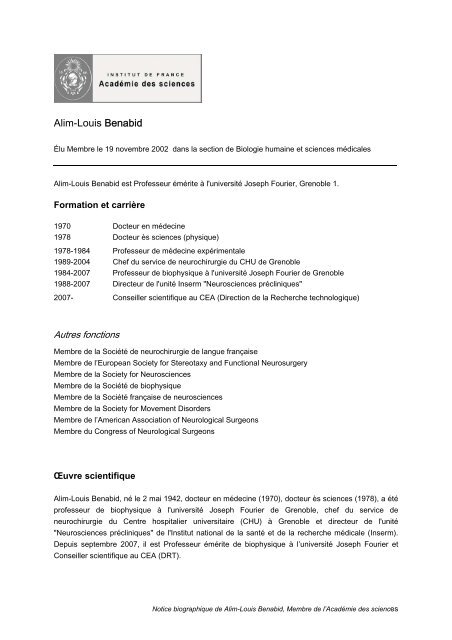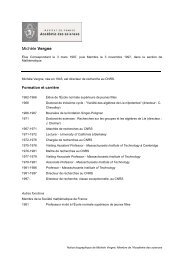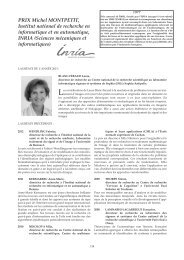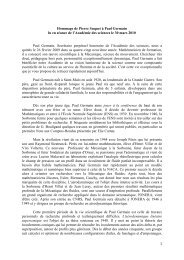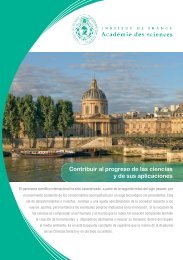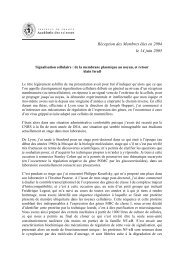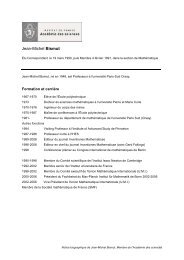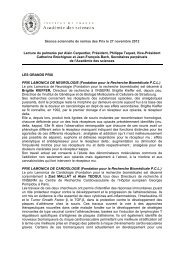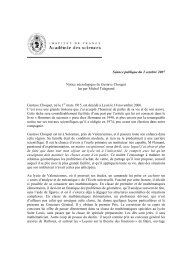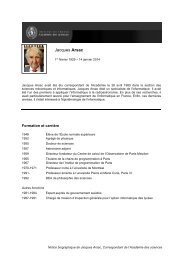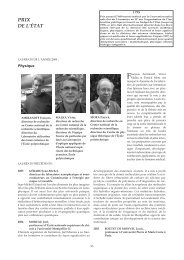C.V. de Alim-Louis Benabid - Membre de l'Académie des sciences
C.V. de Alim-Louis Benabid - Membre de l'Académie des sciences
C.V. de Alim-Louis Benabid - Membre de l'Académie des sciences
Create successful ePaper yourself
Turn your PDF publications into a flip-book with our unique Google optimized e-Paper software.
<strong>Alim</strong>-<strong>Louis</strong> <strong>Benabid</strong>Élu <strong>Membre</strong> le 19 novembre 2002 dans la section <strong>de</strong> Biologie humaine et <strong>sciences</strong> médicales<strong>Alim</strong>-<strong>Louis</strong> <strong>Benabid</strong> est Professeur émérite à l'université Joseph Fourier, Grenoble 1.Formation et carrière1970 Docteur en mé<strong>de</strong>cine1978 Docteur ès <strong>sciences</strong> (physique)1978-1984 Professeur <strong>de</strong> mé<strong>de</strong>cine expérimentale1989-2004 Chef du service <strong>de</strong> neurochirurgie du CHU <strong>de</strong> Grenoble1984-2007 Professeur <strong>de</strong> biophysique à l'université Joseph Fourier <strong>de</strong> Grenoble1988-2007 Directeur <strong>de</strong> l'unité Inserm "Neuro<strong>sciences</strong> précliniques"2007- Conseiller scientifique au CEA (Direction <strong>de</strong> la Recherche technologique)Autres fonctions<strong>Membre</strong> <strong>de</strong> la Société <strong>de</strong> neurochirurgie <strong>de</strong> langue française<strong>Membre</strong> <strong>de</strong> l’European Society for Stereotaxy and Functional Neurosurgery<strong>Membre</strong> <strong>de</strong> la Society for Neuro<strong>sciences</strong><strong>Membre</strong> <strong>de</strong> la Société <strong>de</strong> biophysique<strong>Membre</strong> <strong>de</strong> la Société française <strong>de</strong> neuro<strong>sciences</strong><strong>Membre</strong> <strong>de</strong> la Society for Movement Disor<strong>de</strong>rs<strong>Membre</strong> <strong>de</strong> l’American Association of Neurological Surgeons<strong>Membre</strong> du Congress of Neurological SurgeonsŒuvre scientifique<strong>Alim</strong>-<strong>Louis</strong> <strong>Benabid</strong>, né le 2 mai 1942, docteur en mé<strong>de</strong>cine (1970), docteur ès <strong>sciences</strong> (1978), a étéprofesseur <strong>de</strong> biophysique à l'université Joseph Fourier <strong>de</strong> Grenoble, chef du service <strong>de</strong>neurochirurgie du Centre hospitalier universitaire (CHU) à Grenoble et directeur <strong>de</strong> l'unité"Neuro<strong>sciences</strong> précliniques" <strong>de</strong> l'Institut national <strong>de</strong> la santé et <strong>de</strong> la recherche médicale (Inserm).Depuis septembre 2007, il est Professeur émérite <strong>de</strong> biophysique à l’université Joseph Fourier etConseiller scientifique au CEA (DRT).Notice biographique <strong>de</strong> <strong>Alim</strong>-<strong>Louis</strong> <strong>Benabid</strong>, <strong>Membre</strong> <strong>de</strong> l’Académie <strong>de</strong>s <strong>sciences</strong>
<strong>Alim</strong>-<strong>Louis</strong> <strong>Benabid</strong> a centré ses travaux sur plusieurs pathologies neurochirurgicales, en particulierles tumeurs cérébrales et les mouvements anormaux, en développant la chirurgie stéréotaxique.La fréquence et la gravité <strong>de</strong>s tumeurs cérébrales ainsi que l'absence <strong>de</strong> traitement médical ontconduit <strong>Alim</strong>-<strong>Louis</strong> <strong>Benabid</strong> à mettre au point <strong>de</strong>s métho<strong>de</strong>s chirurgicales, notamment stéréotaxiques,incluant <strong>de</strong>s biopsies stéréotaxiques <strong>de</strong> tumeurs à <strong>de</strong>s fins <strong>de</strong> diagnostic et <strong>de</strong> recherche. À partir <strong>de</strong>ces biopsies, la création <strong>de</strong> banques <strong>de</strong> tissus lui a permis, avec son équipe, <strong>de</strong> caractériser lestumeurs cérébrales par cartographie oncogénique. Des étu<strong>de</strong>s ultérieures <strong>de</strong> génomique et <strong>de</strong>protéomique ont mis en évi<strong>de</strong>nce les facteurs participant à la progression tumorale et ont conduit à<strong>de</strong>s ouvertures thérapeutiques, telles que les facteurs anti-angiogéniques. D'autre part, <strong>Alim</strong>-<strong>Louis</strong><strong>Benabid</strong> a mis au point, pour <strong>de</strong>s patients atteints <strong>de</strong> maladie <strong>de</strong> Parkinson grave et résistant autraitement médical, l'implantation d'électro<strong>de</strong>s et leur stimulation à haute fréquence. Il a ainsi obtenu,par inhibition <strong>de</strong>s structures cérébrales profon<strong>de</strong>s, la disparition <strong>de</strong>s symptômes moteurs(tremblement, akinésie, rigidité) <strong>de</strong> la maladie. Cette intervention, d'abord appliquée au thalamus et aupallidum, puis à d'autres structures comme le noyau subthalamique, a une efficacité remarquable, unetrès faible morbidité et permet <strong>de</strong> diminuer les traitements médicaux. Elle constitue actuellement letraitement chirurgical le plus efficace <strong>de</strong> la maladie <strong>de</strong> Parkinson et apporte également <strong>de</strong>s donnéesfondamentales d'un intérêt théorique considérable. <strong>Alim</strong>-<strong>Louis</strong> <strong>Benabid</strong> a élargi les indications <strong>de</strong> lastimulation électrique profon<strong>de</strong> à d'autres pathologies : dystonies, épilepsie rebelle, troublesobsessionnels compulsifs , algies vasculaires, obésité.<strong>Alim</strong>-<strong>Louis</strong> <strong>Benabid</strong> s'oriente actuellement vers la compréhension <strong>de</strong>s mécanismes d'action <strong>de</strong> lastimulation cérébrale profon<strong>de</strong> à haute fréquence et la mise en évi<strong>de</strong>nce <strong>de</strong> ses possibles effets àlong terme, en particulier neuroprotecteurs, sur l'évolution naturelle <strong>de</strong> la maladie <strong>de</strong> Parkinson. Ils'attache également à l'i<strong>de</strong>ntification précise <strong>de</strong>s cibles efficaces et <strong>de</strong>s réseaux neuronaux mis en jeulors <strong>de</strong> cette intervention et aux perspectives ouvertes par les nanotechnologies.Au CEA, il supervise un programme <strong>de</strong> développement <strong>de</strong>s interfaces Cerveau-Machine, <strong>de</strong>stiné à lacompensation <strong>de</strong>s déficits neurologiques.Mots clés : robotique médicale, neuro-oncologie, maladie <strong>de</strong> Parkinson, épilepsie, stimulationélectriqueDistinctions et Prix<strong>Membre</strong> d'honneur <strong>de</strong> la Société belge <strong>de</strong> neurologieCorrespondant <strong>de</strong> l'Académie nationale <strong>de</strong> mé<strong>de</strong>cine<strong>Membre</strong> <strong>de</strong> l'Institut universitaire <strong>de</strong> France (1999)<strong>Membre</strong> <strong>de</strong> l’Académie royale <strong>de</strong> mé<strong>de</strong>cine <strong>de</strong> Belgique (2002)Docteur Honoris causa <strong>de</strong> l'université <strong>de</strong> Galway (Irlan<strong>de</strong>), <strong>de</strong> l'université <strong>de</strong> London(Ontario), <strong>de</strong> l'université McGill <strong>de</strong> Montréal (Canada)Prix Électricité-Santé <strong>de</strong> l'EDF (1994)Prix Mé<strong>de</strong>cine et biologie du Comité du rayonnement français (1997)Prix <strong>de</strong> la recherche biomédicale PCL <strong>de</strong> l'Académie <strong>de</strong>s <strong>sciences</strong> (1998)Prix <strong>de</strong> l'œuvre scientifique <strong>de</strong> la Fondation nationale pour la promotion <strong>de</strong> la santé etNotice biographique <strong>de</strong> <strong>Alim</strong>-<strong>Louis</strong> <strong>Benabid</strong>, <strong>Membre</strong> <strong>de</strong> l’Académie <strong>de</strong>s <strong>sciences</strong>
le développement <strong>de</strong> la recherche (Algérie, 1999)Prix Jean Vala<strong>de</strong> <strong>de</strong> la Fondation <strong>de</strong> France (1999)Prix Klaus Joachim Zülch <strong>de</strong> la Gertrud Reemtsma Foundation (Cologne, 2000)Scientific Award 2000 <strong>de</strong> l'International Neurobionics Foundation (Hanovre, 2000)Cotzias Award <strong>de</strong> la Société espagnole <strong>de</strong> neurologie (Barcelone, 2000)Médaille Sherrington <strong>de</strong> la Royal Society of Medicine (Londres, 2002)Prix Recherche et santé <strong>de</strong> l'Institut <strong>de</strong>s <strong>sciences</strong> et <strong>de</strong> la santé (2002)Prix <strong>de</strong> la Betty and David Koetser Foundation (Zurich, 2002)Prix Dingebauer <strong>de</strong> la Société alleman<strong>de</strong> <strong>de</strong> neurologie (2002)Spiegel and Wycis Medal (2005)Prix Matmut <strong>de</strong> l'innovation médicale et <strong>de</strong> la Fondation <strong>de</strong> l'avenir (2006)James Parkinson Award (2007)Victor Horsley Award (2007)American Aca<strong>de</strong>my of Neurology's Movement Disor<strong>de</strong>rs Research Award (2008)Prix d'honneur <strong>de</strong> l'Inserm (2008)Chevalier <strong>de</strong>s palmes académiquesChevalier <strong>de</strong> la Légion d'HonneurPublications les plus représentativesBENABID A.L., POLLAK P., GERVASON C., HOFFMANN D., GAO D.M., HOMMELM., PERRET J.E., DE ROUGEMONT J.Long-term suppression of tremor by chronic stimulation of the ventral intermediatethalamic nucleusLancet (1991) 337, 403-406BENAZZOUZ A, PIALLAT B, POLLAK P, BENABID ALResponses of substantia nigra pars reticulata and globus pallidus complex to highfrequency stimulation of the subthalamic nucleus in rats: electrophysiological dataNeurosci Lett. (1995) 189, 77-80LIMOUSIN P., POLLAK P., BENAZZOUZ A., HOFFMANN D., LE BAS J.F.,BROUSSOLE E., PERRET J.E., BENABID A.L.Effect of parkinsonian signs and symptoms of bilateral subthalamic nucleusstimulationLancet (1995) 345, 91-95BENABID A.L., POLLAK P., GAO D.M., HOFFMANN D., LIMOUSIN P., GAY E.,PAYEN I., BENAZZOUZ A.Chronic electrical stimulation of the ventralis intermedius nucleus of the thalamus as atreatment of movement disor<strong>de</strong>rsJ Neurosurg. (1996) 84, 203-214PIALLAT B, BENAZZOUZ A, BENABID AL.Notice biographique <strong>de</strong> <strong>Alim</strong>-<strong>Louis</strong> <strong>Benabid</strong>, <strong>Membre</strong> <strong>de</strong> l’Académie <strong>de</strong>s <strong>sciences</strong>
Subthalamic nucleus lesion in rats prevents dopaminergic nigral neuron <strong>de</strong>generationafter striatal 6-OHDA injection: behavioural and immunohistochemical studiesEur J Neurosci. (1996) 8, 1408-1414GAO D.M., BENAZZOUZ A., BRESSAND K., PIALLAT B., BENABID A.L.Roles of GABA, glutamate, acetylcholine and STN stimulation on thalamic VM in ratsNeuroreport. (1997) 8, 2601-2605LIMOUSIN P., KRACK P., POLLAK P., BENAZZOUZ A., ARDOUIN C., HOFFMANND., BENABID A.L.Electrical stimulation of the subthalamic nucleus in advanced Parkinson's diseaseN Engl J Med. (1998) 339, 1105-1111NI Z., BOUALI-BENAZZOUZ R., GAO D.M., BENABID A.L., BENAZZOUZ A.Changes in the firing pattern of globus pallidus neurons after the <strong>de</strong>generation ofnigrostriatal pathway are mediated by the subthalamic nucleus in the ratEur J Neurosci. (2000) 12, 4338-4344NI Z., GAO D.M., BENABID A.L., BENAZZOUZ A.Unilateral lesion of the nigrostriatal pathway induces a transient <strong>de</strong>crease of firing ratewith no change in the firing pattern of neurons of the parafascicular nucleus in the ratNeuroscience (2000) 101, 993-999BENABID A.L., MINOTTI L., KOUDSIE A., DE SAINT MARTIN A., HIRSCH E.Antiepileptic effect of high-frequency stimulation of the subthalamic nucleus (CorpusLuysi) in a case of medically intractable epilepsy caused by focal dysplasia: A 30-month follow-upNeurosurgery (2002) 50, 1385-1392KRACK P., BATIR A., VAN BLERCOM N., CHABARDES S., FRAIX V., ARDOUIN C.,KOUDSIE A., DOWSEY-LIMOUSIN P., BENAZZOUZ A., LE BAS J.-F., BENABID A.-L, POLLAK P.Five years follow-up of bilateral stimulation of the subthalamic nucleus in advancedParkinson's disease.N Engl J Med. (2003) 349, 1925-1934BENABID A.-L., WALLACE B., MITROFANIS J., XIA R., PIALLAT B., CHABARDESS., BERGER F.A putative generalized mo<strong>de</strong>l of the effects and mechanism of action of highfrequency electrical stimulation of the central nervous systemActa Neurol Belg (2005) 105, 149-57XIA R., BERGER F., PIALLAT B., BENABID A.-L:Alteration of Hormone and Neurotransmitter Production in Cultured Cells by High andLow Frequency Electrical StimulationActa Neurochir. (Wien) (2007) 149, 67-73Notice biographique <strong>de</strong> <strong>Alim</strong>-<strong>Louis</strong> <strong>Benabid</strong>, <strong>Membre</strong> <strong>de</strong> l’Académie <strong>de</strong>s <strong>sciences</strong>
WALLACE B.A., ASHKAN K., HEISE C.E., FOOTE K.D., TORRES N., MITROFANISJ., BENABID A.-L.Survival of midbrain dopaminergic cells after lesion or <strong>de</strong>ep brain stimulation of thesubthalamic nucleus in MPTP-treated monkeys.Brain (2007) 130, 2129-45VIDAILHET M., VERCUEIL L., HOUETO J.-L., KRYSTKOWIAK P., BENABID A.-L.,CORNU P., LAGRANGE C., TEZENAS DU MONTCEL S., DORMONT D., GRANDS., BLOND S., DETANTE O., PILLON B., ARDOUIN C., AGID Y., DESTEE A.,POLLAK P.French Stimulation du Pallidum Interne dans la Dystonie (SPIDY) Study Group.Bilateral <strong>de</strong>ep-brain stimulation of the globus pallidus in primary generalized dystonia.N. Engl. J. Med. (2005) 352, 459-67BENABID A.-L., CHABARDES S., SEIGNEURET E.Deep-brain stimulation in Parkinson's disease: long-term efficacy and safety - Whathappened this year?Curr. Opin. Neurol. (2005) 18, 623-630VIDAILHET M., VERCUEIL L., HOUETO JL., KRYSTKOWIAK P., LAGRANGE C.,YELNIK J., BARDINET E., BENABID A.-L., NAVARRO S., DORMONT D., GRANDS., BLOND S., ARDOUIN C., PILLON B., DUJARDIN K., HAHN-BARMA V., AGID Y.,DESTEE A., POLLAK P., FRENCH SPIDY STUDY GROUP.Bilateral, pallidal, <strong>de</strong>ep-brain stimulation in primary generalised dystonia: aprospective 3 year follow-up study.Lancet Neurol. (2007) 6(3):223-9Le 12 décembre 2008Notice biographique <strong>de</strong> <strong>Alim</strong>-<strong>Louis</strong> <strong>Benabid</strong>, <strong>Membre</strong> <strong>de</strong> l’Académie <strong>de</strong>s <strong>sciences</strong>


